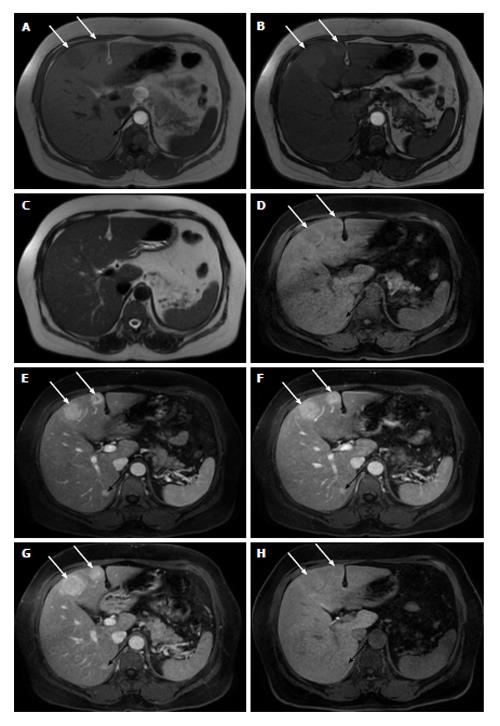Copyright
©The Author(s) 2015.
World J Hepatol. Aug 8, 2015; 7(16): 1987-2008
Published online Aug 8, 2015. doi: 10.4254/wjh.v7.i16.1987
Published online Aug 8, 2015. doi: 10.4254/wjh.v7.i16.1987
Figure 12 Multiple focal nodular hyperplasias.
In- (A) and opposed-phase (B) GRE T1-WI, fat-suppressed FSE T2-WI (C), pre (D) and post hepatocyte-specific contrast agent (Eovist®) fat-suppressed 3D-GRE T1-WI at the arterial (E), portal venous (F), interstitial (G) and hepatobiliary (H) phases. There are two focal nodular hyperplasias on the left lobe (white arrows) and one small FNH on the right lobe (black arrow). The liver parenchyma shows drop of signal in the opposed-phase (B) comparing to the in-phase images (A), indicating moderate parenchymal fat deposition. Note that the lesions do not show drop in signal in the opposed-phase (B). All lesions are isointense comparing to the surrounding liver on T2-WI (C), showing uniform blush on the early post-contrast images (E). In this case the lesions enhancement do not fade to isointensity on the delayed post-contrast images (F and G) due to the presence of moderate fat deposition in the liver parenchyma. On the hepatobiliary phase, 20 min after the administration the hepatocyte-specific contrast agent, the lesions show uptake of the contrast agent. GRE: Gradient-echo; FSE: Fast spinecho; T1-WI: T1-weighted images.
- Citation: Matos AP, Velloni F, Ramalho M, AlObaidy M, Rajapaksha A, Semelka RC. Focal liver lesions: Practical magnetic resonance imaging approach. World J Hepatol 2015; 7(16): 1987-2008
- URL: https://www.wjgnet.com/1948-5182/full/v7/i16/1987.htm
- DOI: https://dx.doi.org/10.4254/wjh.v7.i16.1987









